|
University of Dayton Fieldhouse
Dayton, Ohio
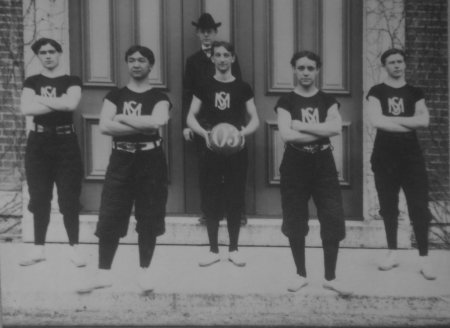
First Basketball team of St. Mary's Institute - 1903
University of Dayton display photo courtesy
Sharon
The University of Dayton got its start in 1849 when a group of missionaries, members of the Society of Mary, left France to undertake educational work in America and
later traveled to Dayton to help cope with a cholera epidemic. They started a school on a farm on the southern edge of the city and St. Mary’s Institute was incorporated in
1878. They began playing basketball at the school in 1903 and in 1912 it became known as St. Mary’s College.1
During the 1919-20 season, St. Mary's changed its name to the University of Dayton and was admitted to the Ohio College Association.
In 1922, eager to upgrade its basketball program, they collaborated in
the construction of the floor in the new Montgomery County Fairgrounds Coliseum and the Flyers
(named in recognition of Dayton natives Orville and Wilbur Wright) played home games there from 1923 through the 1949-50
season.2
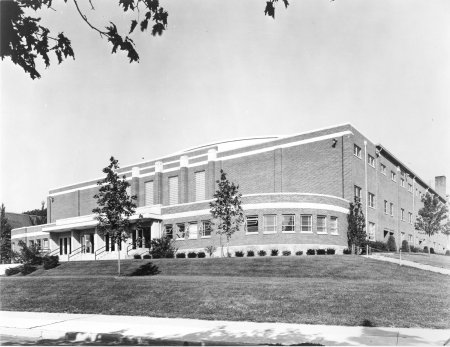
University of Dayton Fieldhouse - c. 1950s
Photo courtesy Sandra Braman and the University of
Dayton - Archives
A great “flood” of students rushed to the campus after World War II.1 Tom Blackburn was hired as head basketball coach in 1947 and the Flyers turned in a 12-14 record in 1947-48, the last losing season he would have
there.3 On May 3, 1949, the University broke ground on a $600,000 on-campus basketball facility at the corner of Alberta and L streets. The facility sat 5,800 for basketball and the UD Flyers moved there on November 29,
1950.4 Realizing the importance of sports, Dayton businesses donated $500,000 to help build the
fieldhouse. Dayton basketball was a way to get the area's name out on a national level and Coach Blackburn's winning teams of local-boys brought capacity crowds. It was a highlight of the University’s over-all
growth.1
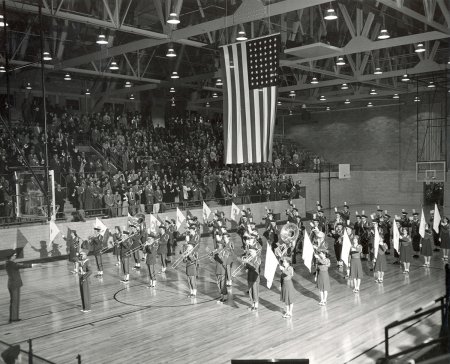
Interior of the U.D. Fieldhouse - ca.1960s
Photo courtesy Sandra Braman and the University of
Dayton - Archives
On May 27, Elvis, Scotty, Bill and DJ performed two shows at the UD
Fieldhouse in Dayton. It was the last stop on a tour of the
Midwest that month that included stops in Minnesota,
La Crosse, Wisconsin, Little Rock, Arkansas,
Kansas, Nebraska and Detroit among others. The
day before, they had performed in Columbus. The
tour featured the same acts for most if not all of the shows which
included The Flaim brothers and their orchestra, Irish tenor Frank
Connors, comedian Phil Maraquin and the Jordanaires.
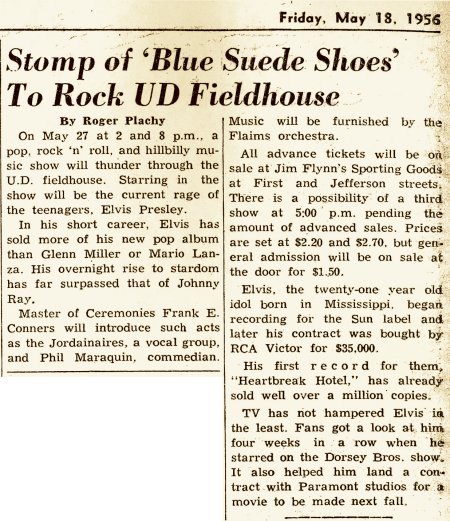
Article in U of D. school paper announcing Elvis'
performance - May 18, 1956
Photo courtesy Sandra Braman and the University of
Dayton - Archives
Advertisement for the show in the local papers commenced
in the weeks prior and on the 18th the University's newspaper had a
small article announcing the show and mistakingly referring to Frank
Connors as the emcee. An article in the Dayton Daily News on the
day of the show announced that local deejays, Al Morris from WAVI and WING's Gene "By Golly" Barry would each emcee one of the shows. The shows were scheduled for 2:00 and 8:00
leaving the option open to add a third if ticket sales warranted, as the
UD article mentioned, but apparently it didn't. In fact neither show was
filled to capacity.
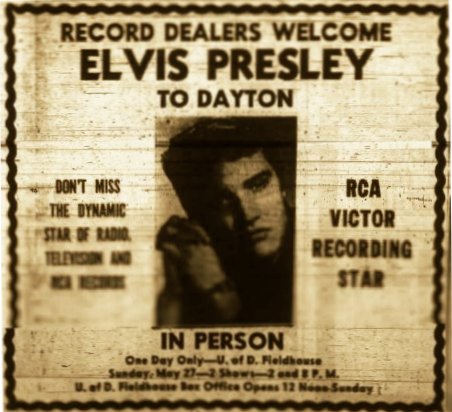
Ad in Dayton Daily News - May 27, 1956
courtesy Dayton
Metro Library
 ELVIS IN ACTION Remove the guitar and the casual observer might think
the young man pictured above was being attacked by a horde of red ants.
Actually, its Elvis Presley all wound up in one of the numbers that make
him currently the hottest item in show business. Elvis will be in Dayton
Sunday for two shows at U. D. Fieldhouse, one at 2 p. m. and again at 8
p. m. ELVIS IN ACTION Remove the guitar and the casual observer might think
the young man pictured above was being attacked by a horde of red ants.
Actually, its Elvis Presley all wound up in one of the numbers that make
him currently the hottest item in show business. Elvis will be in Dayton
Sunday for two shows at U. D. Fieldhouse, one at 2 p. m. and again at 8
p. m.

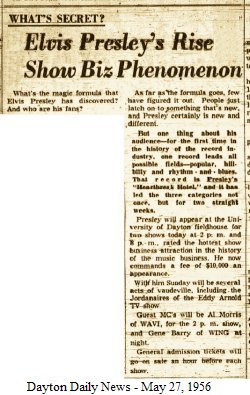 WHAT'S SECRET? WHAT'S SECRET?
Elvis Presley's Rise
Show Biz Phenomenon
What's the magic formula that Elvis Presley has discovered? And who
are his fans?
As far as the formula goes, few have figured it out. People just latch
on to something that's new, and Presley certainly is new and different.
But one thing about his audience--for the first time in the history of
the recording industry, one record leads all possible fields--popular,
hillbilly and rhythm - and - blues. That record is Presley's
"Heartbreak Hotel." and it has led the three categories not
once, but for two straight weeks.
Presley will appear at the University of Dayton fieldhouse for two shows
today at 2 p. m. and 8 p. m., rated the hottest show business attraction
in the history of the music business. He now commands a fee of $10,000
an appearance.
With him Sunday will be several acts of vaudeville, including the
Jordanaires of the Eddy Arnold TV show. Guest MC's will be Al Morris of
WAVI, for the 2 p. m. show, and Gene Barry of WING at night.
General admission tickets will go on sale an hour before each show.
In the mid '50s, famed American artist, painter and photographer Marvin
Israel was working as the art director for Seventeen magazine where he
was responsible "for commissioning many distinguished photographers,
including Diane and Allan Arbus, Robert Frank, and Lee Friedlander. But Marvin reserved two
photographic assignments for himself: he recorded James
Dean on the set of Giant in 1955 and Elvis Presley in 1956. Traveling
with Edwin Miller, a writer for Seventeen, they caught up with him in
Dayton, Ohio, hanging out with the band in the fieldhouse between shows.5
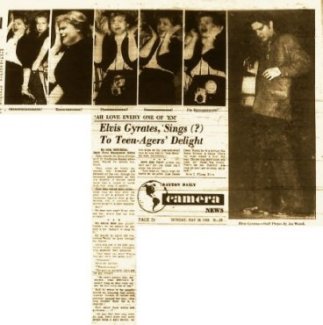
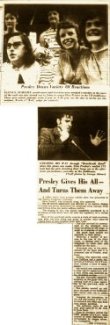
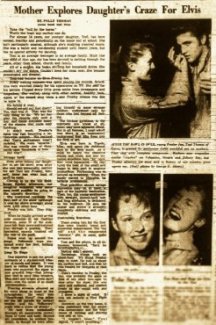
reviews and a column after the shows in the Dayton Daily
News and Journal Herald - May 28,29 1956
courtesy Dayton
Metro Library
At the time, Dayton had two daily news papers, the Journal Herald,
considered the "conservative" morning paper, and the "liberal" Dayton
Daily News with a larger circulation in the newspaper. Each
reviewed the show but neither were all too favorable. Gee Mitchell of
the Daily News wrote, They waited for Elvis Presley at U.D. Fieldhouse Sunday afternoon. Waited for almost two
hours.6
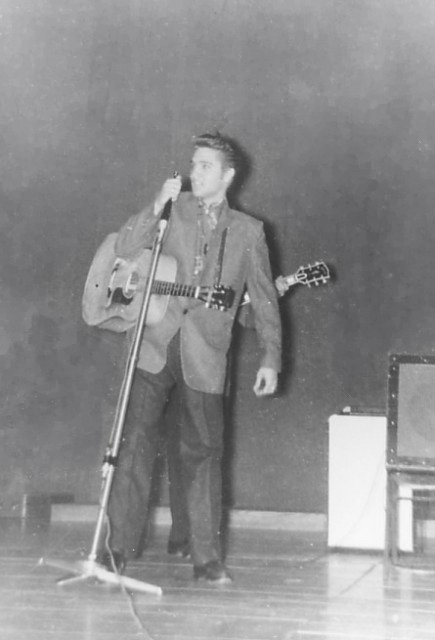
Elvis performing during first show in the fieldhouse -
May 27, 1956
Photo courtesy
Brian Petersen
Then, when he finally appeared, they screamed and shrieked all the way through his 30-minute
performance so its doubtful if anyone heard more than a couple of words from him, sung or spoken.6
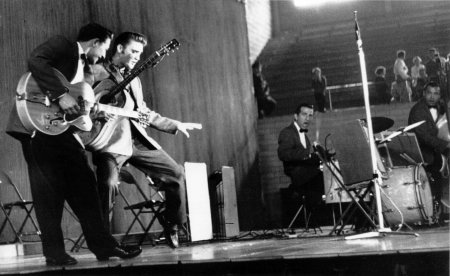
Scotty, Elvis, DJ and Bill perform during first show in
the fieldhouse - May 27, 1956
Photo by Marvin Israel © Lawrence Israel courtesy "Elvis
Presley 1956"
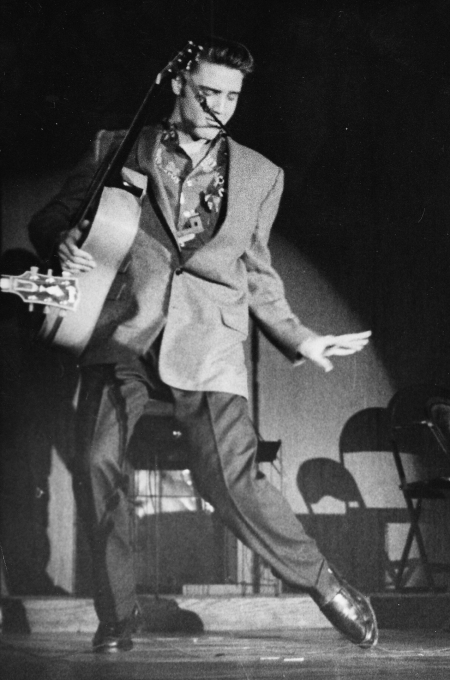
Elvis, DJ and Bill perform during first show in
the fieldhouse - May 27, 1956
Daily News Archive Photo courtesy Wright
State University Libraries, added June 27, 2014
Then they waited some more, more than an hour after the show to get a
glimpse of this Tennessee fugitive from a barber shop who is currently the hottest property in show business.6
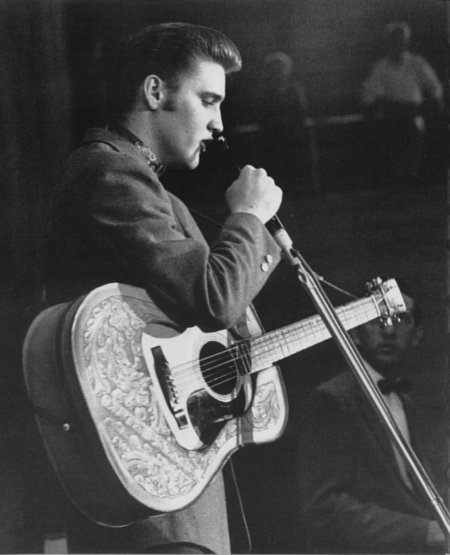
Elvis performing during first show in the fieldhouse -
May 27, 1956
Photo by Marvin Israel © Lawrence Israel courtesy "Elvis
Presley 1956"
Why? To hear him sing? If so, why did they drown him out with screams?
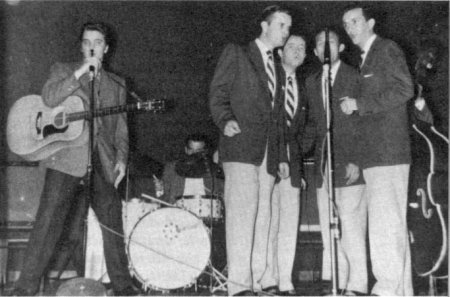
Elvis performing during first show in the fieldhouse -
May 27, 1956
Photo courtesy Paul Lichter's "The Boy Who Dared To Rock"
To hear him play guitar? Couldn't be, he admits he just uses it for
"sump'n to hang on to."
Or maybe to watch his contortions while he goes through his routine.6

Dayton Daily News Photo courtesy Dayton Public Library
Archives
Let's ask one of the 3000 (promoter’s count) mostly teenagers who squealed their adulation.
"How about you miss? What's this guy have that sends you?" "O-o-o-o-oh"
Let's try another.
"M-m-m-m-mmm"6
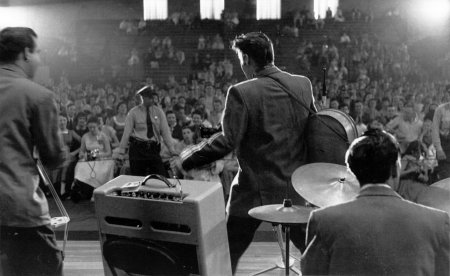
Bill, Elvis and DJ performing during first show in the
fieldhouse - May 27, 1956
Photo by Marvin Israel © Lawrence Israel courtesy "Elvis
Presley 1956"
This gets us nowhere. Let's ask the guy himself. "Ah cain't answer that, An' anyhow, what difference it make? Long as they come see me. Ah love every one of
'em." 6
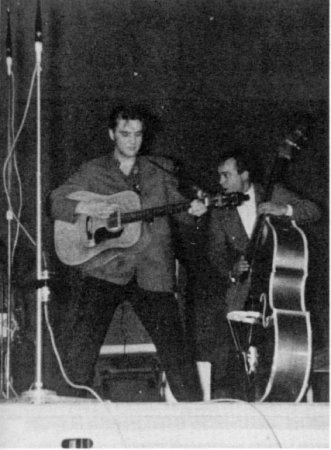
Elvis performing during first show in the fieldhouse -
May 27, 1956
Photo courtesy Paul Lichter's "The Boy Who Dared To Rock"
And to prove it he soundly bussed an inquiring high school reporter (female of course) and playfully mussed her hair. (One long shudder from the h. s. reporter.)
Well, about those antics and gyrations ...?
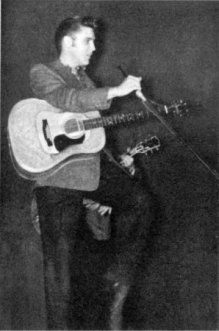 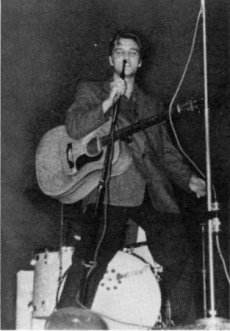
Elvis performing during first show in the fieldhouse -
May 27, 1956
Photos courtesy Paul Lichter's "The Boy Who Dared To
Rock"
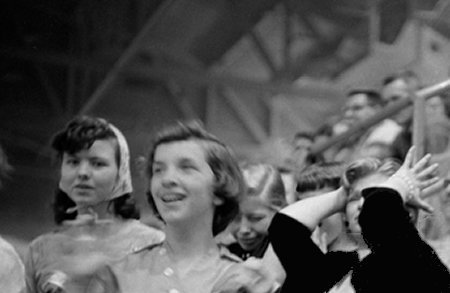
fans react to Elvis performing in the fieldhouse -
May 27, 1956
Photo by Phil Harrington © Evan Harrington, corrected Oct. 16, 2014
"Ah jus' feel that way when Ah sing. Don't know why some people think it ain't decent." (At two stops on his year-and-a-half tour he was told to "tone down" his body movements.)6
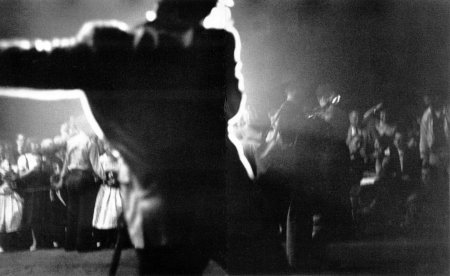
Elvis performing during first show in the fieldhouse -
May 27, 1956
Photo by Marvin Israel © Lawrence Israel courtesy "Elvis
Presley 1956"
HOW DID THAT screen test turn out? Do you think you'll make the movies?
"Sure hope so, that's what Ah wanta be, an actor. Like James Dean. Wanta be in a picture like Rebel Without A Cause. This's too tough makin a
livin' this way. Movies you don't work alla time, An' make big money. That's for me.
Travelin' alla time Ah don't get no sleep. Ah'm tard."
Som' I. S'Long, Elvis.6
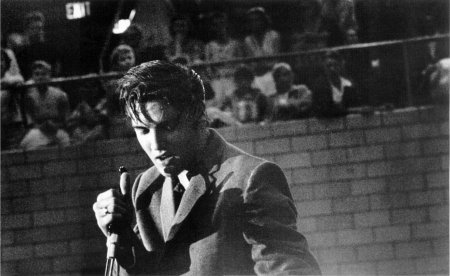
Elvis performing during first show in the fieldhouse -
May 27, 1956
Photo by Marvin Israel © Lawrence Israel courtesy "Elvis
Presley 1956"
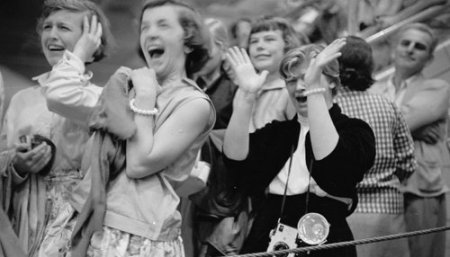
fans react to Elvis performing in the fieldhouse -
May 27, 1956
Photo by Phil Harrington © Evan Harrington, corrected Oct. 16, 2014
Jim O'Connor of the Journal Herald wrote,
A rather better than average variety show was presented at the Dayton fieldhouse yesterday.
Elvis Presley, who allegedly sings, also appeared. His 20 minute appearance was devoted to an obscene display of bumps and grinds, punctuated by occasional moos,
bayings, wails and bellows from the public address system.7
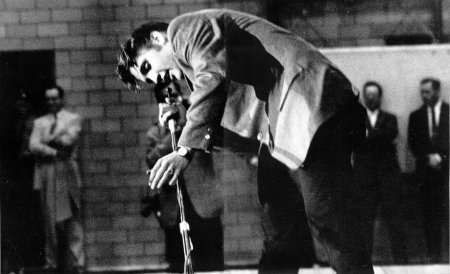
Elvis performing during first show in the fieldhouse -
May 27, 1956
Photo by Marvin Israel © Lawrence Israel courtesy "Elvis
Presley 1956"
The singing, if any, was almost completely smothered by a shrieking section which went off with the regularity of a cuckoo clock.
Most of the scattered adults were in a state of semi-consciousness after the first bump and grind. A number were observed wiping tears of pure laughter from their eyes.7

Elvis performing during first show in the fieldhouse -
May 27, 1956
Photo by Marvin Israel © Lawrence Israel courtesy "Elvis
Presley 1956"
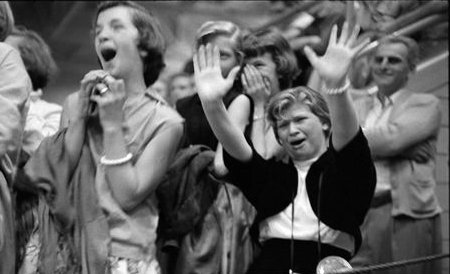
fans react to Elvis performing in the fieldhouse -
May 27, 1956
Photo by Phil Harrington © Evan Harrington, corrected Oct. 16, 2014
The star received his comeupance at the afternoon show when he slithered off stage to await an avalanche of applause.
His small band stayed expectantly in their places. However, a number of persons in the rear of the
fieldhouse, in obvious need of air, staggered to their feet and headed for the door.7
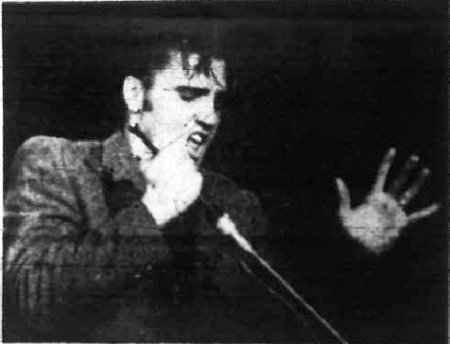
GYRATING HIS WAY through "Heartbreak
Hotel" when this photo was made, Elvis Presley's soulful(?) look
had the girls shrieking their lungs out at the afternoon performance
yesterday at the fieldhouse.
Journal Herald Staff photo by George Adams
Everybody else, to the astonishment of the band and it is presumed also of Presley, went home.
Presley, who reportedly owns two Cadillacs and a sports car, arrived at 3:40 p.m. for a 2 p.m. show without a word of explanation.7
(A 3:40 start for his segment of a 2:00 show was not all
that late. However, it was late enough apparently for DJ to not
have time to set up his drums and instead used the set belonging to the
drummer of the Flaim's Orchestra for the first show.)
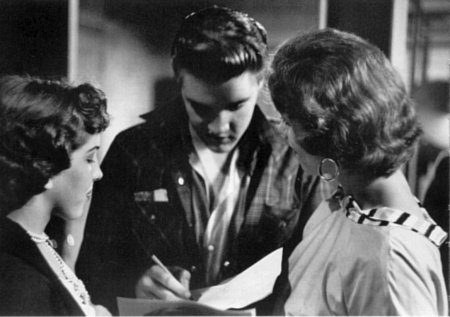
Elvis signing autographs between shows in the fieldhouse
- May 27, 1956
Photo by Marvin Israel © Lawrence Israel courtesy "Elvis
Presley 1956"
His arrival was announced by a press agent's appearance with a shoe which was bestowed upon the shrieking section.
The star eventually appeared, sneaking on the stage with sidelong look of a man expecting to be served a summons.7
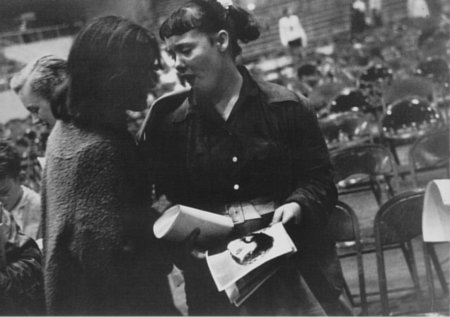
Fans get autographs between shows in the fieldhouse - May
27, 1956
Photo by Marvin Israel © Lawrence Israel courtesy "Elvis
Presley 1956"
The shrieks washed up and down the walls of the fieldhouse like heavy seas on a rock shore.
Grasping the microphone by the end and leaning it far over, he launched into what may have been almost anything.
The audience, about 80 per cent girls aged 10 to 20, took it from there.
Prior to Presley's arrival the 1,800 persons present were treated to some legitimate entertainment by among others, the
Jordanaires.7
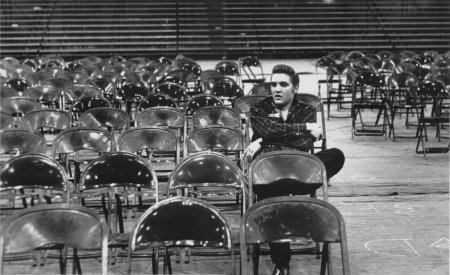
Elvis between shows in the fieldhouse - May 27, 1956
Photo by Marvin Israel © Lawrence Israel courtesy "Elvis
Presley 1956"
Polly Thomas, a staff writer for the Journal Herald,
attended the show with her daughter and wrote about it in a column days
after. She wrote,Take the "bull by the horns."
That's the least any mother can do.8
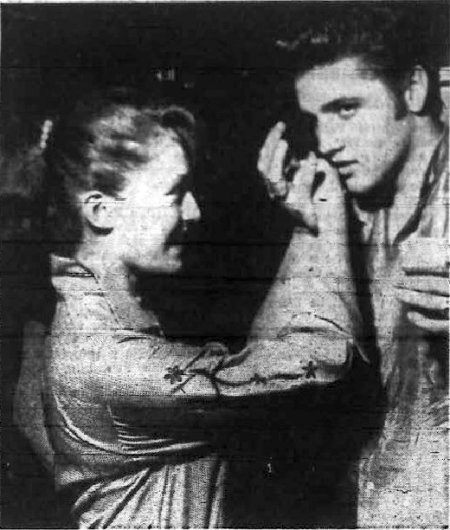
AFTER THE BAWL IS OVER, young Presley fan, Toni
Thomas of Eaton, is greeted by performer (with watchful eye on mother).
They chat with complete composure. Mothers may remember similar
"crushes" on Valentino, Sinatra and Johnny Ray, but Presley
admirers are most avid in history of our country, press agents say.
|
|
Journal Herald Staff photo by George Adams |
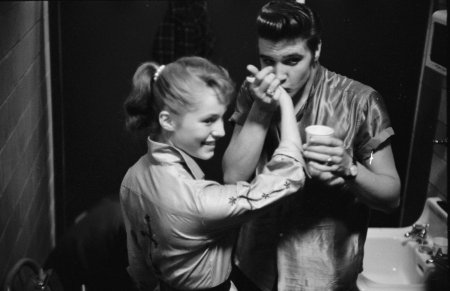
Elvis kisses Toni Thomas' hand backstage in the fieldhouse - May
27, 1956
Photo by Phil Harrington © Evan Harrington, corrected Oct. 16, 2014
For almost 14 years, our younger daughter, Toni, has been normal, healthy and periodically on the honor roll at school. She isn't particularly musical, although she's studying classical music. She was a ballet and toe-dancing student until recent years, but has no special affinity for dancing.8
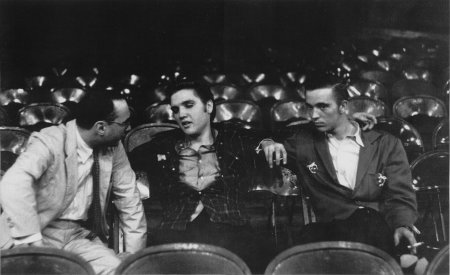
Elvis interviewed between shows with Gene Smith - May 27,
1956
Photo by Marvin Israel © Lawrence Israel courtesy "Elvis
Presley 1956"
Toni is an average teen-ager in an average family. Much like any child of that age, she has been devoted to nothing through the years, other than school, church and family.
All of a sudden, she began shirking her household duties. She couldn't dry the dishes. Couldn't keep her room neat. She became preoccupied and dreamy.8
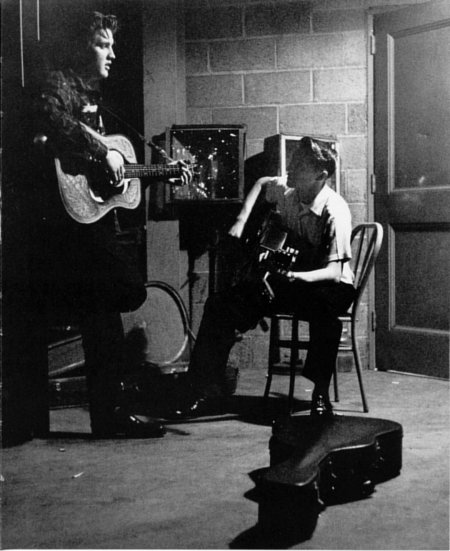
Elvis and Scotty between shows in the fieldhouse - May
27, 1956
Photo by Marvin Israel © Lawrence Israel courtesy "Elvis
Presley 1956"
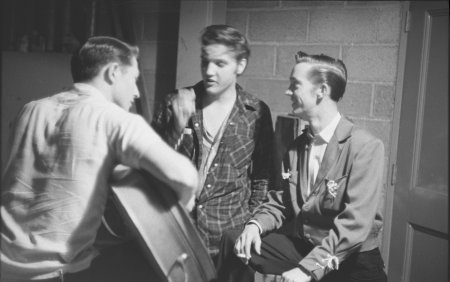
Scotty, Elvis and Gene backstage between shows in the fieldhouse - May
27, 1956
Photo by Phil Harrington © Evan Harrington, corrected Oct. 16, 2014
Toni had become an Elvis Presley fan.
Every waking moment was spent playing his records. Schedules were watched closely for his appearance on TV. She sent for his picture. Clipped every little press notice from newspapers and magazines. She waited, along with other normal, healthy teenagers at the record shop when a new Presley release was due to come in.8
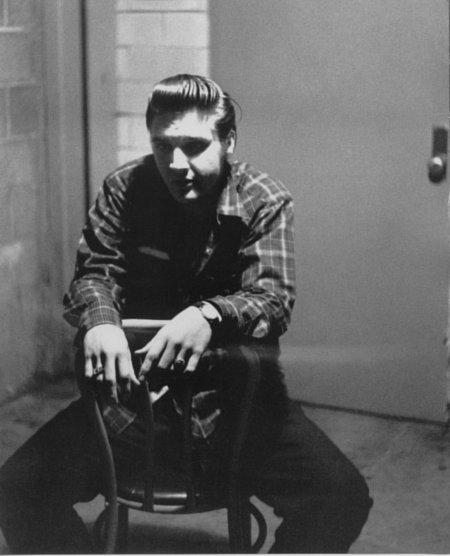
Elvis sits backstage between shows at the fieldhouse -
May 27, 1956
Photo by Marvin Israel © Lawrence Israel courtesy "Elvis
Presley 1956"
We talked it over.
Should we put out foot down? Yes, that was it. That was the only thing to do. We let her play the records only once a day, and made available many of the classics that made easy listening.8
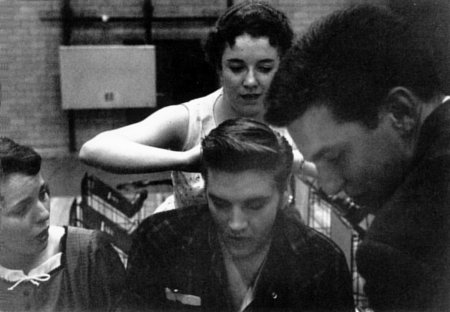
Elvis talks with fans between shows in the fieldhouse -
May 27, 1956
Photo by Marvin Israel © Lawrence Israel courtesy "Elvis
Presley 1956"
It didn't work. Presley's fame was fast becoming a nation-wide subject. We realized that Toni's enthusiasm wasn't isolated. We were "squares." She was
merely one of thousands upon thousands of fans.
But why?8
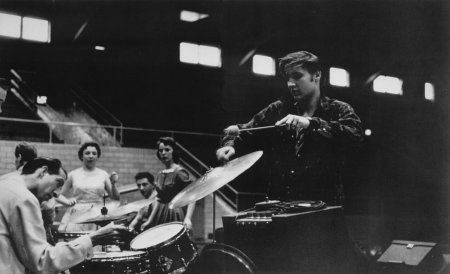
DJ, Elvis and fans between shows in the fieldhouse - May
27, 1956
Photo by Marvin Israel © Lawrence Israel courtesy "Elvis
Presley 1956"
Strange Spell
Even after taking our daughter to see his show, even after she met him personally, neither we nor Toni nor Presley, himself, know just what kind of spell he casts.8
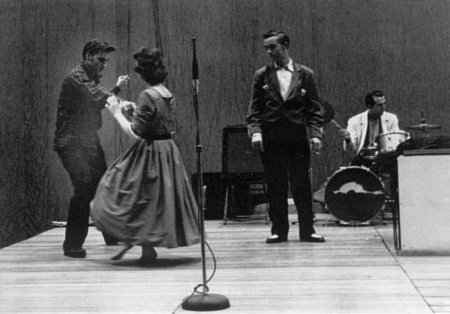
Elvis, fan, Gene Smith and DJ between shows in the
fieldhouse - May 27, 1956
Photo by Marvin Israel © Lawrence Israel courtesy "Elvis
Presley 1956"
Coming in to the UD field house Sunday afternoon, our daughter wondered why some cars could posibbly be going in the opposite direction!8
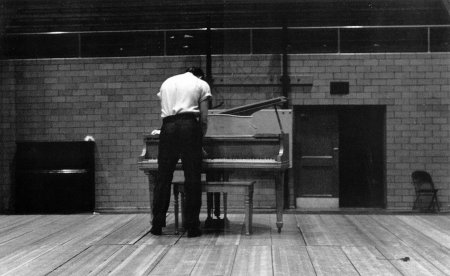
Elvis between shows in the fieldhouse - May 27, 1956
Photo by Marvin Israel © Lawrence Israel courtesy "Elvis
Presley 1956"
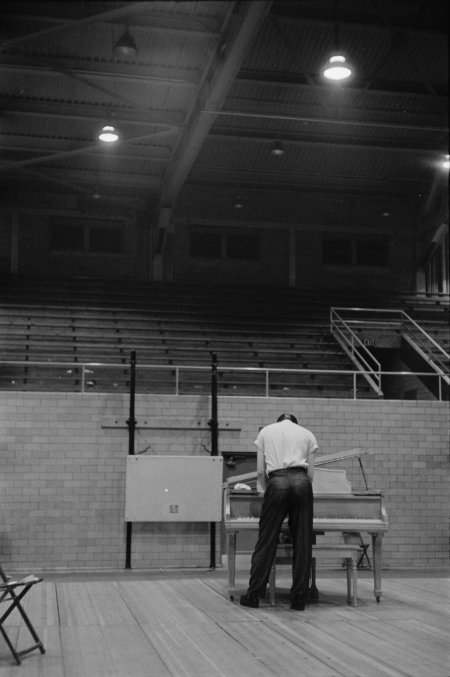
Elvis between shows in the fieldhouse - May 27, 1956
Photo by Phil Harrington © Evan Harrington, corrected Oct. 16, 2014
She weathered restlessly the first half of the show (although it was far above average) along with 2,000 other fans.
Presley was late. They fidgeted.8
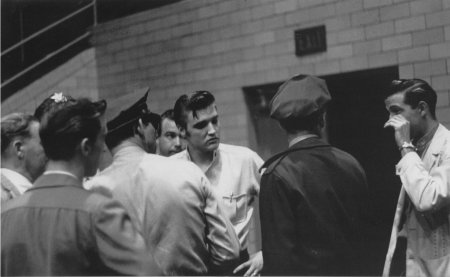
Gene Smith, Bill, Elvis and DJ with the police in the
fieldhouse - May 27, 1956
Photo by Marvin Israel © Lawrence Israel courtesy "Elvis
Presley 1956"
When he finally arrived at the side entrance in his Cadillac caravan, some 50 of the audience left their seats and watched him through a grating. Their hysterical squeals touched off the rest of the pack.
Ropes went up around the stage. Policemen were stationed every few feet, holding the ropes taut.8
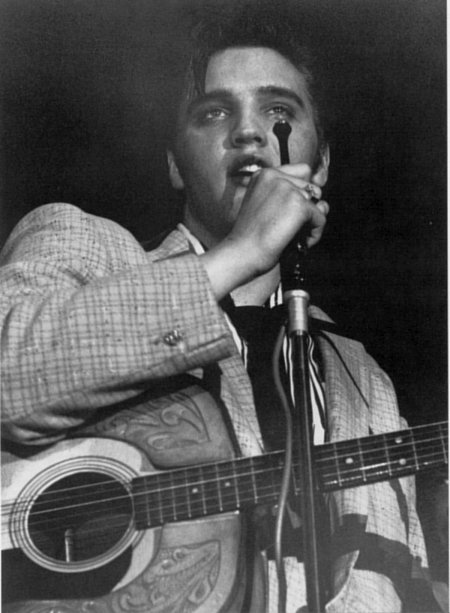
Elvis onstage for the second show at the fieldhouse - May
27, 1956
Photo by Marvin Israel © Lawrence Israel courtesy "Elvis
Presley 1956"
Leap To Stage
One expected to see the grand entrance of a six foot tall master of moods and music. It was hard to realize that the young man who mounted the stage in one graceful leap--that youngster clad in navy blue trousers, blue shirt and bright green sport coat--was the cause of so much pandemonium.8
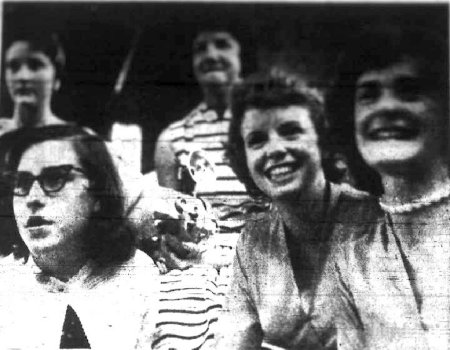
Presley Draws Variety of Reactions - ECSTASY, DISBELIEF, wonderment and boredom were mingled
yesterday in the faces of the cool cats who turned out to listen to
singer Elvis Presley at the UD fieldhouse. These girls waited patiently
from 2 p.m. to 3:40 p.m. for the star to arrive for the matinee. worth
it? Well, judge for yourself.
|
|
Journal Herald Staff photo by George Adams |
Piercing screams silenced as he wove about in front of the microphone. He went into "Heartbreak Hotel" (top seller on the hit parade for several weeks) and his followers went into a state of shock!
He took them ecstatically through all conceivable contortions of voice and body. Beyond all precedence, he worked tirelessly, as though he were offering himself to some strange medium, understood only by those who feel beyond all feeling.8
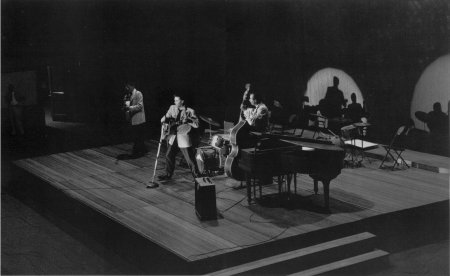
Scotty, Elvis, DJ and Bill during second show in the
fieldhouse - May 27, 1956
Photo by Marvin Israel © Lawrence Israel courtesy "Elvis
Presley 1956"
The obvious gyrations, to the unartistic eye (most of all, mine) may have appeared ribald. But in all fairness, I must admit that there is an explanatory background that lifts them into the field of art.8
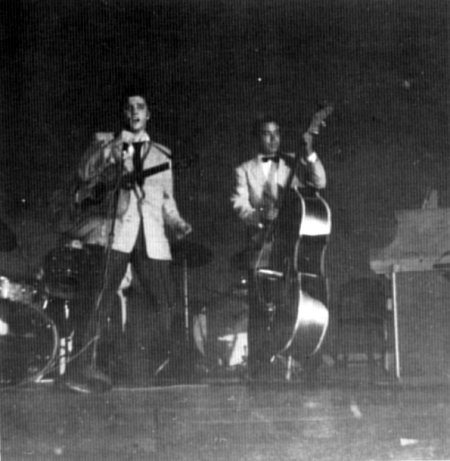
Elvis and Bill during second show in the fieldhouse - May
27, 1956
Photo courtesy Brian
Petersen's "Atomic Powered Singer"
Elvis was born in Tupelo, Miss., and spent his childhood in the deep south. As a child he heard the plaintive chants and blues, and saw potential shoeshine boys "jig" until they were exhausted. He captured the best of the south and began to take part in amateur productions. Performing was as natural as breathing. When the family moved to Memphis, he became professional.8
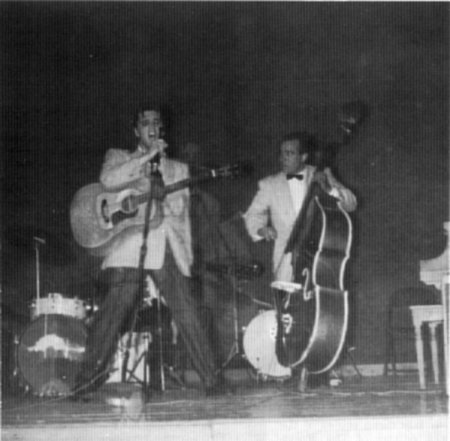
Elvis and Bill during second show in the fieldhouse - May
27, 1956
Photo courtesy Brian
Petersen's "Atomic Powered Singer"
That primitive almost savage expression may be, in itself, a part of the hypnotic fascination. Then, too, the young
southerner with straight, slicked-back hair and long sideburns, is dedicated to his audience. He sets his course and steers it straight, completely oblivious and uninhibited.8
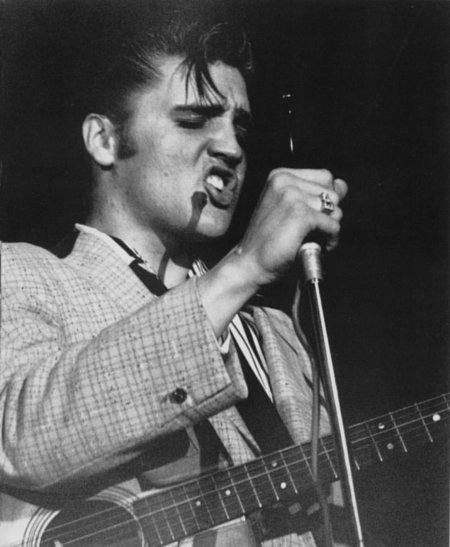
Elvis performing during second show in the fieldhouse -
May 27, 1956
Photo by Marvin Israel © Lawrence Israel courtesy "Elvis
Presley 1956"
Contrasting Reactions.
Those seeing him for the first time were, frankly, bored and somewhat embarrassed. The "leg roll" and the
exaggerated "shimmy," are, to some, quite awesome.8
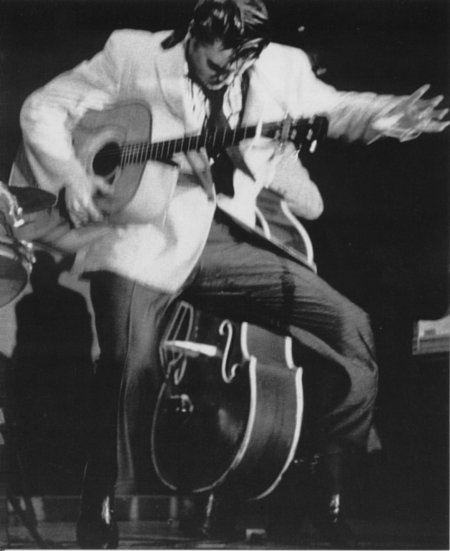
Elvis performing during second show in the fieldhouse -
May 27, 1956
Photo by Marvin Israel © Lawrence Israel courtesy "Elvis
Presley 1956"
Toni and the others, in all innocence, screeched, "Isn't he WONDERFUL?"
Mother didn't answer.
Backstage, things took an about face. We found Presley easy to meet. He told us about his mother and dad, and that he was headed for Memphis to visit them.8
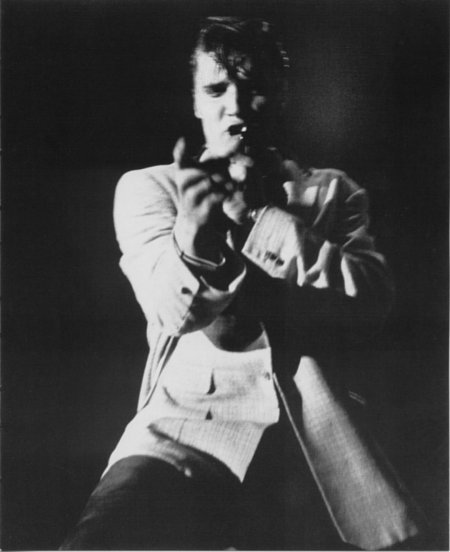
Elvis performing during second show in the fieldhouse -
May 27, 1956
Photo by Marvin Israel © Lawrence Israel courtesy "Elvis
Presley 1956"
Toni's reaction to Presley, the boy, was probably the same as that of any other teen-ager he sees after the show. She was calm and collected and chatted freely as she would with any youngster.
I drew a sigh of relief. It was not entirely a Pied Piper story.8
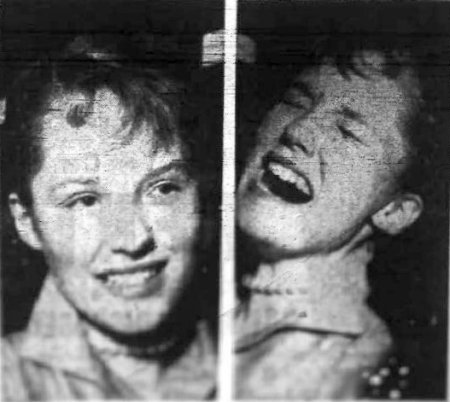
Toni Thomas of Eaton, OH at the UD Fieldhouse - May 27,
1956
Journal Herald Staff photos by George Adams
However, on the way home, it was mentioned that the singer was immaculate and the fragrance of bathing and shaving was still on him.
"I wouldn't know," Toni sighed. "I wasn't breathing!" 8
The following day Elvis, along with Marvin Israel and
Edwin Miller in tow, flew to Memphis where they continued their
assignment for Seventeen. The band drove. After a few
days rest they headed for California for several appearances
and the Milton Berle show.
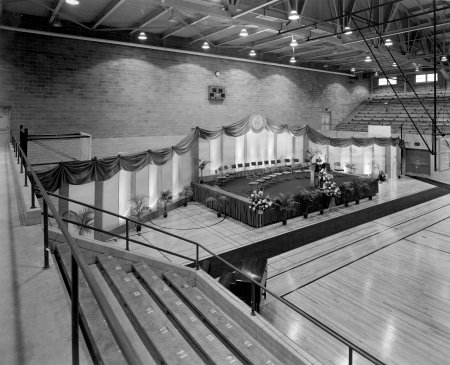
Interior of the UD Fieldhouse endstage setup facing
rear
Photo courtesy Sandra Braman and the University of
Dayton - Archives
The Flyers had made it to the National Invitational Tournament
almost every year since the 1950-51 season at Madison Square Garden in New
York and in 1962 were the tournament champions.1
After 16 consecutive winning seasons, Coach Blackburn succumbed to cancer at the age of 58 in March of 1964 during what would have been his
17th.3 On November 29th of that year the fieldhouse hosted a visit by
the Rev. Martin Luther King, who was also late.
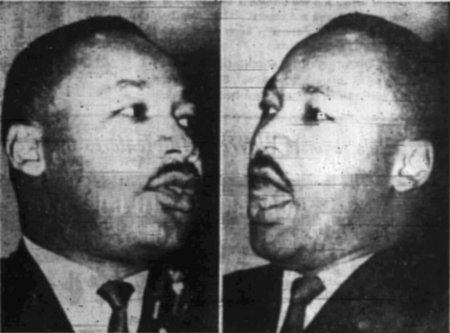
The Rev. Martin Luther King at UD Fieldhouse - Nov. 29,
1964
Dayton Daily News Photo by Bill Koehler courtesy
Jump Back Honey
While King spoke in the Fieldhouse to a throng of more than 6,200
people about three scriptural ideas of love — eros, philadelphia and
caritas — protestors from the National States Rights Party marched
outside, carrying signs bearing messages antithetical to Kings:
”Communist King, go home!" and “Go Home Martin Luther Coon," recalled
Father Jack Kelley, S.M.9
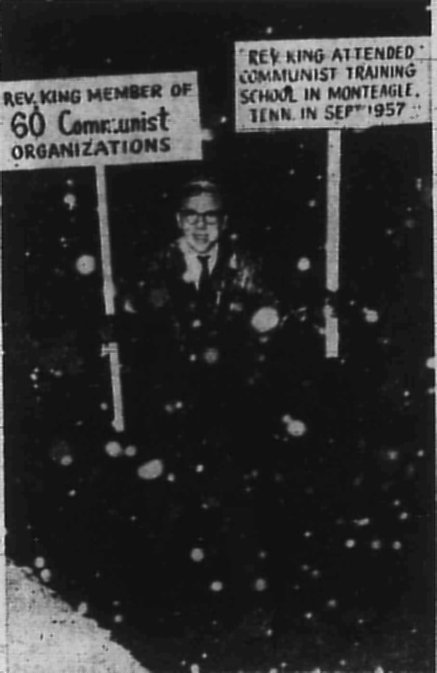
Protester carries two signs - Nov. 29, 1964
Dayton Daily News Photo by Bill Koehler courtesy
Jump Back Honey
King was on campus that snowy night for Dayton’s
Freedom Forum, sponsored by the Rev. George Lucas of the Bethany
Baptist Church in Dayton. Kelley helped Lucas to arrange King’s
appearance on campus, which was delayed almost two hours by a
snowstorm between Cincinnati and Dayton.9
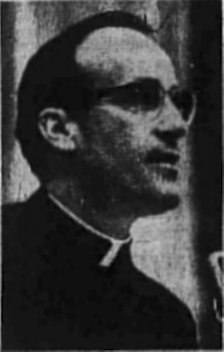
Father Jack Kelley - Nov. 29, 1964
Dayton Daily News Photo by Bill Koehler courtesy
Jump Back Honey
While the crowd waited for the charismatic champion of civil rights,
Kelley took the opportunity to promote fair housing efforts in Dayton,
which had been strained since the Dayton City Commission had voted down
a fair housing ordinance proposed by the NAACP earlier that month.9
When King finally arrived, he started with a joke: “I’d rather be late
and Martin Luther King than the late Martin Luther King."9

The Rev. Martin Luther King at UD Fieldhouse - Nov. 29,
1964
Dayton Daily News Photo by Bill Koehler courtesy
Jump Back Honey
In Kings one-hour oration that night, he called blacks to action,
imploring them to exercise their right to vote as one powerful and
nonviolent way to effect change at all levels of government, said
Kelley, who espoused King’s philosophies as he did those of the slain
Indian leader Mahatma K. Gandhi, whose doctrine, Satyagraha, advocated
similar nonviolent resistance and noncooperation to combat British
rule in India. ”9
NEGRO LEADER ADDRESSES 6,500 HERE
Violence Not Answer, King Says
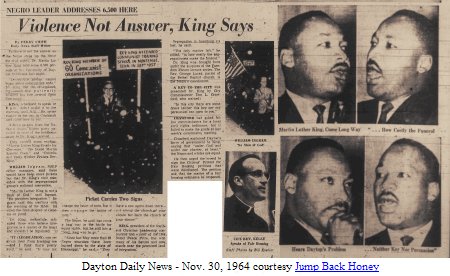 By PERRY SMITH
By PERRY SMITH
Daily News Staff Writer
Violence is not the answer as the Negro steps up the drive for civil rights, Dr Martin Luther King told some 6,500 persons at the University of Dayton fieldhouse last night.
"Destructive means cannot bring about constructive ends," Dr. King told the oft-applauding crowd that patiently waited his late arrival from Cincinnati.
KING, scheduled to speak at 8 p.m. didn't make it to the rostrum until 9:15. He spoke earlier in the day in Cincinnati and came here by car.
Fifteen pickets from the National State Rights party paraded in front of the fieldhouse prior to Dr. King's arrival.
They carried signs reading, "Martin Luther King Fronts for Commies," - "Go Home Martin Lucifer Coon," and "Communist Daily Worker Praises Rev. King."
WILLIAM Ingram, NSRP office manager, said there would have been more pickets but that Dr. King's visit coincided with the segregationist
group's national convention.
"Martin Luther King is not a man of God," said Ingram. "He preaches integration." Ingram
said this conflicts with the teaching of the Bible. He cited the first chapter of Genesis as proof.
Dr. King, meanwhile ridiculed those who believe integration is a matter of
the heart and shouldn't be legislated.
"IT (LEGISLATION) can restrain them from lynching me -- and I think that's pretty good," he said. "It may not change the heart of men, but it does change the habits of men."
The Negro, he said, has come a long way in the battle for equal rights, but he still has a "long, long way to go."
"Since last May more than 40 Negro churches have been burned down in the state of Mississippi," he said. "They have a new motto down there -- not attend the church of your choice but burn the church of your choice."
KING, president of the Southern Christian Leadership conference and winner of the Nobel Peace Prize, has won many of the battles and now stands near the
promised land of integration.
Segregation is breathing its last, he said.
"The only matter left," he added, "is how costly the segregationists make the funeral."
Dr. King was brought here under the auspices of the Freedom Forum lecture series. The Rev. George Lucas, pastor of the Bethel Baptist church is the forum's coordinator.
A KEY TO THE CITY was presented to Dr. King by City Commissioner Don L. Crawford, who warned:
"In this city there are some doors neither this key nor my persuasion can open for you."
CRAWFORD had asked fellow commissioners for a local civil rights ordinance, but it failed to make the grade at last
week's commission meeting.
Crawford explained Dayton's form of government to King, saying that "under God and under our charter, at least," the Negro and whites are equal.
He then urged the crowd to sign the Citizens Protest for Fair Housing petitions that were distributed. The petition ask that the matter of a fair housing ordinance be reopened.
The ballot box was King's hope for the future, and he spoke for
nonviolence with every movement, every word from his mouth," Kelley
said. He remembered the speech of that night well; just weeks later,
King delivered it again as he accepted the Nobel Peace Prize.9
King became the youngest person to receive the prize for his work to end
racial segregation and racial discrimination through civil disobedience
and other non-violent means. He was assassinated in Memphis on April 4,
1968.

University of Dayton Fieldhouse - c. 1990s
Photo courtesy Sandra Braman and the University
of Dayton - Archives
The Fieldhouse served as home court for the Dayton Flyers until the $4.5 million
UD Arena was completed
the following year, in 1969. In nineteen years the flyers had
compiled a winning 256-33 record in the fieldhouse.4
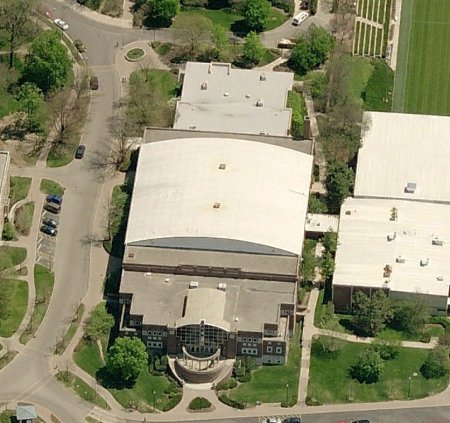
Aerial view of the Thomas J. Frericks Athletic and Convocation Center
- 2008
Photo courtesy Microsoft Earthdata
The Fieldhouse then served as a training facility for sports teams, a recreation complex for UD students and office space for the athletic department. In 1975, the Physical Activities Center was built and joined to the south side of the Fieldhouse. In the late 1980s, the University renovated the interior of the facility and updated the western external facade of the
Fieldhouse.10
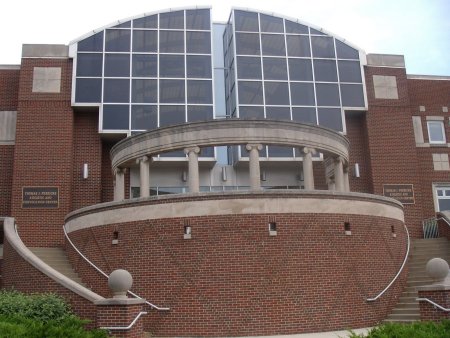
The Thomas J. Frericks Athletic and Convocation Center -
June 2008
Photo by
Sharon
Thomas J. Frericks attended UD from 1949-1953 and played basketball for Coach Tom Blackburn. Frericks later returned to UD to serve as Athletic Director for a total of 21 years. During his tenure, he helped regulate collegiate sports in the best interest of athletes and assisted the NCAA in making a nationwide impact. Frericks had a major hand in the construction of UD
Arena.11 Following
his death the University renamed the Fieldhouse in his honor.4
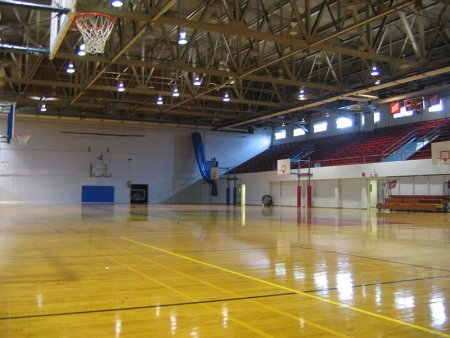
Interior of the Frericks Center facing
rear - 2008
Photo by Greenstrat courtesy Wikipedia
Today the Thomas J. Frericks Athletic and Convocation Center is a 5,000 seat volleyball-only facility, the third-largest in college volleyball and home to the Flyers volleyball teams. Since 1997 the Frericks center's red and blue floor was a
"Sport Court" volleyball floor but was
replaced along with major renovations in 2009.12

Interior of the Frericks Center during renovations - 2009
Photo courtesy Dayton
Flyers Photo Gallery
Spectator viewing has been upgraded also. The rafters
have been cleared of unnecessary objects and the ceilings have been
painted white to increase brightness in the facility. A new roof was also
included in the $300,000 renovation of the Frericks Center.13
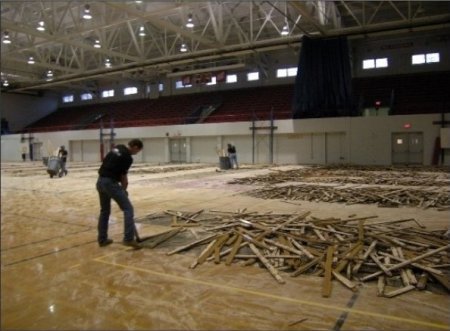
Frericks Center renovation floor removal - 2009
Photo courtesy Dayton
Flyers Photo Gallery
The gym floor that once provided the base of the court has been replaced with a state-of-the-art Robbins Bio-channel court and the
"Sport Court" surface has been removed in favor of a return to hardwood. The multi-layered surface helps reduce the toll taken on a player's body during the explosive movements in volleyball and Frericks now has one of the best floors in Division I
volleyball.
13

Interior of the Frericks Center facing
rear - 2009
Photo courtesy Dayton
Flyers Photo Gallery

Interior of the Frericks Center facing
rear - 2009
Photo courtesy Dayton
Flyers Photo Gallery

Interior of the Frericks Center facing front - 2009
Photo courtesy Dayton
Flyers Photo Gallery
The court is painted red with the Dayton Flyers logo mark on both sides of the court running parallel to the out of bounds line, University of Dayton borders the court on the end lines of the court. The floor has been marked solely for volleyball and is marked for two more practice courts that can be used when the facility is configured for practice.
13
In 1989 Father Kelley expressed frustration that despite UD's annual
Martin Luther King celebration, few people even realized King appeared
on campus and were further unaware of King's powerful message of that
evening.9 If they weren't aware of it since, then they are
now. In January of 2009 a recording of King's speech was
discovered by David Schock, a filmmaker in Grand Haven, Mich. He found
the unlabeled reel-to-reel tape in a box of recordings by Herbert
Woodward Martin, a UD poet and professor emeritus who is the subject of
a film by Schock.14
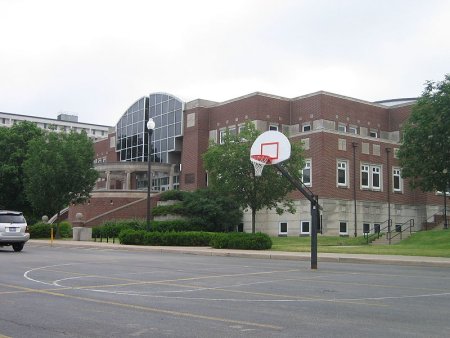
The Thomas J. Frericks Athletic and Convocation Center -
2008
Photo by Greenstrat courtesy Wikipedia
Marvin Israel's photographic career was largely confined to a six—year
period in the 1950s and is, compared to his widely influential
contribution as an art director, virtually unknown today. Israel’s
stark, uncompromising black and whites must have appeared unsettling,
and only two of his five—hundred photographs of Elvis were published at
the time. He died of a
heart attack in Dallas, Texas, in the spring of 1984. Until 1998,
with the publication of "Elvis
Presley 1956," his compelling
photo—documents of Elvis, taken in the last few months before informal
access to him was vetoed by his management, had remained
unpublished and unknown.5
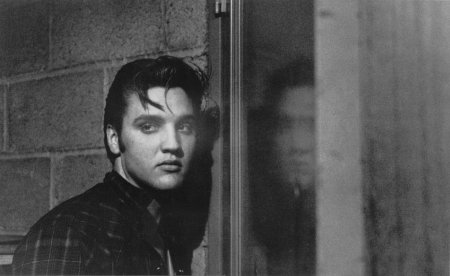
Elvis Presley between shows in the UD Fieldhouse - May
27, 1956
Photo by Marvin Israel © Lawrence Israel courtesy "Elvis
Presley 1956"
page added June 29, 2009
Special thanks Brian
Petersen for his assistance with photo identification and leads, to
Carrie Williams and the staff of the Local History Reference Dept. of
the Dayton
Metro Library for their assistance and articles from the
Dayton Daily News and the Journal Herald, and also to Sandra Braman and
the University of
Dayton Archives for copies of photos and University publications.
Phil Harrington's photos appear on this
site with the permission of Evan Harrington with respect to his father
and family and for which we greatly appreciate their use. As of December 2014 we have been informed
that all of Phil Harrington's photos including the ones pictured here are now and only licensed through Corbis.
Evan Harrington expects to have a system up and running to sell individual
prints direct soon.
1
according to "UNIVERSITY OF DAYTON
Potential Unlimited"
by Kay Timmon - Sep. 1965
2
according to "HISTORICAL PERSPECTIVE ON THE MONTGOMERY COUNTY FAIRGROUNDS"
by James "Rocky" Whalen
3
according to
Basketball History in Dayton, Ohio by Marc Katz
4
according to "Thomas
J. Frericks Center" courtesy Wikipedia
5
excerpt from "Elvis
Presley 1956" by Martin Harrison 1998
6
from "Elvis Gyrates, Sings (?) To Teen-Agers' Delight"
by Gee Mitchell - Dayton
Daily News - May 28, 1956
7
from "Presley Gives His All -- And Turns Them Away" by Jim
O'Connor - Journal Herald - May 28, 1956
8
from "Mother Explores Daughter's Craze For Elvis"
by Polly Thomas -
Journal Herald - May 29, 1956
9
excerpt from "King's 1964 message to UD:
Love, nonviolence, ballot box are weapons against Injustice" by Maureen Schlangen
- 1989 UD Archives courtesy
Jump Back Honey
10 excerpts from "University
of Dayton Arena" - courtesy Dayton Flyers Official
Athletic Site
11
according to "Thomas
J Frericks 5K" courtesy active.com
12
according to "Thomas J. Frericks Athletic and Convocation Center"
- courtesy Dayton Flyers Official Athletic Site
13
excerpts from "Investing
In Success" Volleyball's Frericks Center Undergoes Significant
Changes" - Jun 1, 2009 - courtesy Dayton Flyers Official
Athletic Site
14
according to "Long-lost
MLK tape of 1964 speech at UD found" By Dave Larsen Dayton Daily
News Feb 25, 2009
Seventeen
Magazine - October 1956
ELVIS PRESLEY:
rising star or passing fad?
by Edwin Miller
Some say he's a passing fad, but Hollywood thinks he's
another Marlon Brando
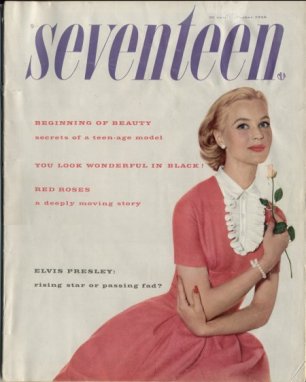 SEVENTEEN recognizes that Elvis Presley is a highly controversial subject. Critics, columnists, parents, religious authorities, psychiatrists and teen-agers have expressed their various opinions. Aware of the enormous reader interest in Elvis
Presley. SEVENTEEN hopes the following informative article will illuminate the background and bring the situation into perspective. SEVENTEEN recognizes that Elvis Presley is a highly controversial subject. Critics, columnists, parents, religious authorities, psychiatrists and teen-agers have expressed their various opinions. Aware of the enormous reader interest in Elvis
Presley. SEVENTEEN hopes the following informative article will illuminate the background and bring the situation into perspective.
Nineteen fifty-six is the year that Elvis Presley, a twenty-one-year-old "holler and jump" vocalist from the deep South, split the great audience of the United States down the middle like a ripe watermelon. Watch television, buy a pop record, tune to a radio disk jockey or put a coin into a jukebox, see a show featuring live music, read movie news- it's difficult to avoid sound, sight or mention of Elvis Presley. Parents and critics
unanimously denounce Elvis as a vocalist who can't sing, as an untalented and tasteless performer; the majority of the country's teen-agers consider listening to and/or watching Elvis the most exciting popular music experience imaginable.
Elvis' spectacular rise is one of the most extraordinary ever seen in the history of pop music. His first RCA Victor album, entitled simply Elvis Presley, sold more than any other pop album in the company's history (700,000 by last August); at the peak his pop singles were selling at the rate of 50,000 a day, constituting three-quarters of
RCA Victor‘s entire pop-single business! In July, Ed Sullivan reportedly offered Elvis
$50,000 to make three appearances on Sullivan's CBS-TV variety show. The first was scheduled for last September 9, the second two follow at approximately eight-week intervals.
Some wonder whether this phenomenon will last. The recording director who discovered Elvis when he was making thirty—five dollars a week driving a pickup truck feels that the market is being saturated too rapidly with Presley recordings, some good, some ducts. Various musical "experts" claim that Elvis will disappear from public sight within a year, vanishing into a limbo of wrecked jukeboxes and worn-out records. Elvis himself wonders about his physical endurance. Speaking of the
ceaseless one—night stands, he shakes his head. "I‘ve traveled over one hundred thousand miles in the last twelve months alone, movin' through more'n twenty states. I love the
travelin'," he sighs, "but this business is pretty rough. I been at it a year, but I‘m ten years older now."
Elvis rubs one side of his face. "Sometimes," his words fall away in a soft, Southern drawl, "sometimes, in a plane, ridin‘ from one town to another, I look out the window and I‘m seared. l'm awful scared. I think about things that've happened and it's kind of like a dream. A year and a half ago, I was nothing. Now I have four Cadillacs, one motorcycle, a three-wheel red Messerschmitt car. I‘m building a swimming pool behind my new house in Memphis. I‘ve got shirts I bought months ago laying there in drawers all over the house; they still got the price tags. I look at them when I get home."
More than anything else in the world today, Elvis wants to be an actor. "If I could click in the movies, I'd give everything else up," he states. "I believe I could get as much, even more satisfaction out of actin` than I can from singin'." Elvis made a screen test last spring for independent producer Hal Wallis and was promptly signed to a seven-year contract with Hal Wallis Productions.
On screen, Elvis has a simple direct appeal, immediate in its impact. According to Joseph Hazen, Wallis' partner, "Elvis’ test revealed a dramatic ability comparable to James Dean and Marlon Brando. He has a great, great natural talent, an
extraordinary sense of timing and delivery."
When Elvis saw his own screen test, however, he was staggered. "I just didn‘t recognize myself. I looked every which way except me, just couldn’t get used to it."


Elvis Aron Presley, named after his father, Vernon Elvis Presley, was born in Tupelo (pop. 11,527), Mississippi, on January 8, 1935. He was a sensitive little boy. Elvis` mother, Gladys Presley, a large, buxom woman with a placid smile, remembers that when Elvis was a little boy, "he was always good-natured and friendly, just like he is today. I was afraid of Elvis being an only child, how he might be stingy and mean, but he was never
that way. He never minded if anyone played with his toys."
Elvis tells how, when he was small, "I always hankered after a Teddy bear; now I go to fairs or carnivals if one’s around where I‘m playing, and try the booths where you toss baseballs and hit things." Elvis adds with quiet pride, "I can hit anything I can see." He wins as many as ten or fifteen prizes at a clip, usually Teddy bears, and he gives most of these away. "You see these kids hanging around, they haven't any money, their eyes
are hungry. I‘m a sentimental fool I guess, but I like kids."
During the last year that the Presleys lived in Tupelo, Elvis' mother persuaded him to get a guitar. "There were these singers around home making out pretty good and she wanted me to sing and play the guitar. But I didn’t care for it too much." Elvis "messed around" with the guitar for a year or so, sang hymns like
I'll Fly Away and Where Could I Go but to The Lord with his folks at gospel sings at The First Assembly of God, appeared at some local song festivals under his mother’s guidance.
In 1948, Elvis' father, who had been driving a banana truck, decided to move the family to Memphis where most of Mrs. Presley’s family lived. He found work in a paint factory. Once Elvis came to Memphis, he and his cousins, Gene Smith and Billy Mann, became inseparable. Elvis’ mother kept a vigilant eye on her boy. Mrs. Presley remarks, "I never let Elvis out of my sight until he was fifteen. I would hold his hand all the time when we went downtown; we knew where he was every minute of the day. If Elvis wasn‘t where he was supposed to be, we went out lookin' for him." Mr. Presley, a graying man of forty, adds, "We brought Elvis up right."
Elvis used to take plenty of "sassing" from his friends about his mother’s restrictions, but the breaking point came when Elvis, Gene and Billy were arguing as to which of the three would own the first car. Elvis, like his two cousins, had always dreamed of a car; one day to his
cousins' exasperation, he insisted he would own two Cadillacs. Finally, Gene and Billy hollered at Elvis, "You wait, even if you got a car, your mother never would let you drive it!" Now Elvis grins at his wan cousin Gene, who is on his staff payroll as traveling companion. "Boy! If I ever told you I'd be hirin’ you to drive my Cadillac, you would have tried to beat the tar out of me for sure!" Gene nods dumbly.
Elvis' father bought him clothes at the credit store. "We were poor," Mr. Presley remarks, "and I was pretty badly in debt. When things got too bad, Mrs. Presley, she would get a job." Mr. Presley adds, "And now he’s started to make it himself, he’s paid us all back. Said he didn’t want us to work anymore."
"My daddy was always good to me," Elvis says, "he was something wonderful. I have more things now, but I always had the basic things I wanted, just not so fancy."
In Memphis, Elvis attended L. C. Humes High School. He was "just an average student-I didn‘t flunk, but I didn‘t do too good." As a senior, Elvis began to worry about the future. "I would lie awake all night wondering what I was going to do. I didn‘t know a trade. I wasn‘t much good at anything. I didn‘t know how I was ever going to make something out of myself." Elvis looks around, a quiet, impassive expression on his face.
He spreads his hands out helplessly, "I could never think of any way out."
During that last year, Elvis went out and got a job. "I would get out of school at two-fifteen in the afternoon; then I worked in a furniture factory making those plastic table tops from three-fifteen until midnight. It got a little rough." Elvis worked at this six months, then found work at a munitions factory along with his cousin Gene, but was discharged when it was discovered that he was under eighteen. Elvis made his highest
salary there (before his music-making days}. averaging about sixty—six dollars a week.
Elvis hadn’t touched a guitar in five years, but during his final year at school, he had the urge to sing again. In 1953, the year he was graduated, Elvis thought to surprise friends at an informal party by playing them a "mystery" record. He went downtown and paid four dollars to Sam Phillips, head of The Memphis Recording Service and its affiliate, Sun Records, to record two songs. One was a sentimental number called
My Happiness, the other, a favorite of the Ink Spots, That's When Your Heartaches
Begin. Intrigued, Phillips noted Elvis' address, and said that he might call him at some future time. When Elvis put the record on the phonograph, nobody believed it was he. “My mother had to vouch for me," he remembers, "it was such a surprise." Elvis sang with a slow, quivering nasal whine that is almost unrecognizable as the Presley of today. He used a twelve-dollar guitar and, as Sam Phillips puts it, "Elvis could break plenty of strings but couldn’t play at all. But his guitar gave him confidence."
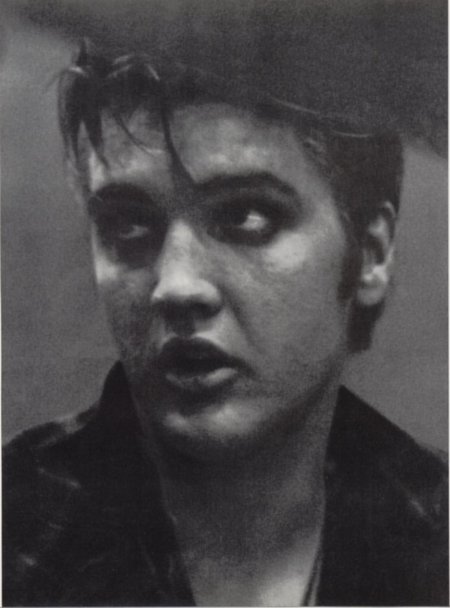
Elvis between shows at the fieldhouse -
May 27, 1956
Photo by Marvin Israel © Lawrence Israel courtesy "Elvis
Presley 1956"
Phillips, who has built a lively reputation in the music business as a recording director with talent for developing artists (he is currently working with vocalist Carl Perkins), called Elvis several months later. He worked with Elvis for three or four sessions, seven or eight hours to a session "to see if I could get something out of him." Finally, Phillips explains, "I persuaded him to relax, just told him to sing everything he knew and let himself go. That did it! . . . I found that Elvis couldn't sing a ballad at all. He is a
'hollerer'; he has a jump style. As a matter of fact, Elvis doesn’t have much of an ear for music. He has a ‘soft’ voice, and occasionally you can’t distinguish between his vocal and the music. I found that if I added an echo chamber to the recording, I could give Elvis' voice a firmer
'line.'"
Once he discovered that Elvis felt at home with jump rhythms, Phillips called in a couple of
musicians - Scotty Moore, "one of the finest hot guitar men around," and Bill Black, "a great slap bull fiddle
man" - and got them to work together. Elvis' voice picked up in speed and rhythm, darkened in vocal color and developed remarkably in a relatively short space of time. Elvis' mother suggested
That’s All Right for his first record. When they were ready to make the master tape, Sam Phillips invited
Dewey Phillips (no
relation), a disk jockey on Memphis' WHBQ, over to sit in. Dewey, Sam recalls, "thought the number was terrific; he could hardly wait to play it." They cut
Blue Moon of Kentucky for the coupling, and finally, Elvis' first professional record was ready to go on the Sun label.
Elvis was so nervous when he heard that Dewey was featuring it on his program that he ran out of the house and went to a movie. "I knew it was going to be on at nine o’clock, but I was just too
nervous to sit there and watch everybody listening to me." Telephone response to the program was so-overwhelming that Dewey called the Presleys to get Elvis down to the station and help him answer the phone. The record sold 150,000 copies.
During the summer of 1954, Elvis made his first appearance as an "extra" act on radio station KWKH's Louisiana Hayride in Shreveport, Louisiana. He was backed then, as now. by Scotty and Bill, and went on to play in Grand Ole Opry in Nashville, In August, only three weeks after the first record had been cut, Bob Neal, a disk jockey on Memphis' WMCT, got Elvis a minor spot in a show at a local auditorium, Overton Park Shell. Sam Phillips says, "The crowd went wild when Elvis did
That’s All Right, and wouldn’t let him off the stage until he followed with
Blue Moon of Kentucky."
From the summer of 1954 until the end of 1955, Elvis cut five records for Sun. (The last was
Mystery Train and I Forgot To Remember To Forget, later released by RCA Victor.) Then Sam Phillips sold Elvis' contract for thirty-five thousand dollars to Steve Sholles, RCA Victor recording director for Country and Western artists. His first record for RCA, made under Sholles' supervision, was Heartbreak Hotel - which Elvis recorded at his mother s suggestion. Released earlier in 1956, this became one of the biggest sellers in
RCA Victor's history.
Elvis generally selects his own song material, mostly from "demonstration records" which are sent to him all the time. He plays the record over several times until he learns the words by heart. He can’t read music, says, "Those sharps and flats - don't know a thing about them!" His entire repertoire consists of some twenty-seven numbers.
Financial success has brought Elvis a great many things he has always wanted though it hasn't as yet gratified two of his childhood ambitions. He always wanted "to ride a horse and ride a motorcycle up a wall, like they do at the county fairs."
"I‘ve been on a horse a couple of times," he says, "but I haven't been able to ride a motorcycle back and forth, zigzagging up the wall the way they do."
Apart from those frustrations, Elvis is enjoying the fruits of success. He recently bought an eight-room ranch-type house in a comfortable residential suburb in east Memphis, where he has installed his father and mother. He retired his father from the paint factory where his uncle, Gene's father. still works, remarking, "My daddy‘s worth more to me at home taking care of my affairs than he is working in a paint factory at
fifty dollars a week." Although Elvis doesn’t get the chance to wear many clothes on the road and prefers to go around the house clad only in a pair of slacks, he enjoys immensely buying clothes, with which he has filled his closets. His favorite color in clothing is black or dark blue. On a typical day, he may wear black and gold horizontally ribbed silk slacks, a pink nylon sport shirt with mother-of-pearl buttons, light green socks, a white cotton jacket with black markings and black loafers.
His early yearning for Cadillacs is in the process of being fulfilled. Currently he owns a pink and white 1955 Cadillac Fleetwood, a blue Cadillac limousine. a yellow Cadillac convertible and a white Cadillac Eldorado, with white leather upholstery, gold buttons and a telephone, custom-built at the cost of ten thousand dollars. (In cars, his taste used to run to pink but he has been tiring of that lately.)
Elvis owns a motorcycle too, a Harley Davidson model, which cost him eleven hundred dollars, and a trim three-wheel German Messerschmitt Cruisette, which he keeps in a garage at the back of the house. The cars are lined up in the driveway where he can feast his eyes on them whenever he stops off between Shows.
In the back of the Presley home is a spacious yard which contains Mrs. Presley's small truck garden, a concrete swimming pool twenty five by fifty feet, a garage, a dog kennel, and a barbecue pit. The inside of the eight-room house is decorated in pastel shades of green, pink and purple; the walls feature various tributes to Elvis. A handtinted, framed and electrically lighted photograph of Elvis hangs over the phonograph; his junior high and high school diplomas certify his education: plaques on the wall cite his awards from music industry trade journals, The Billboard and Cash Box, as the most promising Country and Western artist of the year (1955). Teddy bears of every size, shape and description perch on the sofas, on the beds, on chairs and tables in each room of the
house, mutely testifying to Elvis' skill with a ball. "That house," he remarks. shaking his head. "is practically a museum of me!"
Elvis' home has become quite a point of interest to his fans in all parts of the country. Elvis' father, a burly man with deep—set eyes. states that Elvis gets more than one thousand letters a day, from all over the country as well as from Canada and Alaska too. "We have a special post-office box. Some of the mail just comes to Elvis Presley, Memphis. Tennessee."
The Presleys have been married for twenty-three years. Mrs. Presley, a friendly woman of thirty-nine, describes how people drive in from all over to say hello. "We get folks from Mississippi where some of our relatives live, from Arkansas and Texas, from Louisiana and Florida and Georgia." The Presley telephone number is changed so often Mrs. Presley has to look it up in a book.
Mrs. Presley's eyes grow moist as she talks about Elvis' career. "Money
isn't everything," she says in a hushed voice, "sometimes I can hardly sleep at night for worry about his traveling around
in strange places all over the country." Every other night, however, while Elvis is away, he calls his mother to tell her
he's well.
"It's all kind of like a dream," Mrs. Presley sighs, as she sits with her hands folded quietly in her lap.
Mr. Presley nods, echoes quietly, "It's all kind of like a dream."
The Elvis Presley Show is so organized for its one-night stands that its star comes on after the intermission, following a leather-lunged female vocalist, a comic, two brothers who do musical impersonations, a vocal group known as the
Jordanaires and a small intense rhythm band.
When the master of ceremonies calls his name onstage, the spotlight picks up Elvis ln the wings. Dressed in a loose yellow jacket and dark greenish slacks, wearing a white sport shirt with black tiger stripes, Elvis glides to the center of the stage. With an impassive expression on his pale face, he listens to the deafening chorus of shrill screams which could panic a herd of elephants.
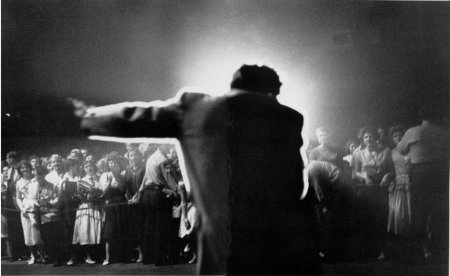
Elvis performing during first show in the fieldhouse -
May 27, 1956
Photo by Marvin Israel © Lawrence Israel courtesy "Elvis
Presley 1956"
No sign now of the restless pacing around his dressing room waiting for his cue, of the comb continuously run
through his long, wavy, chestnut hair, of the fingernails bitten to the quick. With the sure approach of a performer seasoned by two years of personal experience, Elvis grips the microphone as if it were a broom handle, announces, "Ladies and gentlemen,
here's a little song that's a little hot around the nation and some parts of Africa," leans back and "goes" with
Long Tall Sally.
He sings to his microphone as if it were a living thing. He babies it, dandles it, holds it close, pushes it away, is tender and rough by turn. His expression never changes except for the ghost of a good-natured
smile which twitches at the corner of his mouth. Elvis has a ready sense of humor which is recognized by his audience; a well-timed jab of his finger at a writhing fan sends his watchers into a convulsion of laughter.
The selection doesn't actually matter to his audience; lyrics can barely be heard through the excited screaming and clapping and stomping with which they greet him.
Elvis fascinates his audience. They sit there by the thousands: the great majority are teen-age girls, with a sprinkling of kid brothers and sisters, a few older people, some boys-but not many. One girl informed the rest of a line on the way into an
auditorium that "five boy friends left me over Elvis; they can't stand him, say he's no good, or he's ugly or something."
Elvis' audience leans forward in its seats and watches him with utter absorption, concentrating on every movement he makes. Some watch in stunned silence; some are appalled; others shriek with delight, pound the air with their hands. They scream, "Elvis, Elvis, Elvis." "Look at me!" "Look here, Elvis!" Gradually, the audience. which has entered the auditorium quietly and calmly, works itself up into a frenzy.
Elvis sings-his voice shuttles over the scale, ranging from a baritone to a
swooping tenor. (Elvis himself is at a loss to describe his vocal style: "It’s all music, not rock ‘n' roll, not country-style, don’t
know what to call it.")
He changes his movements from one performance to another during the course of his six or seven numbers. He says. "I never know what I'm going to do until I do
it"—an approach which gives his act a spontaneous quality immediately sensed by his audience.
Periodically he ziggles back to stand next to the drummer, who beats out a torrent of staccato rhythm. He rocks back and forth on his toes and heels and snaps his entire body in time to the beat, his voice shouting, "I'm soo lo-onely.
I'm soo lo-onely, that I cou'd die, cou'd d-i-e . . ."
By the time the show is over, he's drenched with perspiration; his chestnut hair is
awry despite the oil applied to make it stay in place (his pet peeve is people who inquire why he doesn't have lt cut); his audience has melted into a single
shrieking mass. A dozen police kneeling in front of the stage hold a rope in case eager fans should get out of control as Elvis dashes off. When he disappears, the show is over; nothing could top him.
Most, if not all, of Elvis‘ admirers are inarticulate when it comes to describing just how he affects them. "Elvis is different." they say. "He makes me feel good" is heard over and over again, along with "He's cute." Elvis' fans differ concerning his personal characteristics: they say he's stupid, smart, probably illiterate, but many add, "If he asked me, I'd marry him in a second."
Occasionally Elvis' admirers get carried away in their desperate attempt to obtain a lasting memento. The first
time, Elvis was in Jacksonville, Florida. "The girls tore my clothes off, even the cuffs of my pants. It happened so fast. I didn't have time to be scared." During and alter every performance, the officials finish counting money made from admissions (prices range up to two and a half dollars), from the sale of Elvis' "autographed" photos at a dollar and a dollar-fifty (depending on their size), from souvenir pamphlets for fifty cents and song books for a dollar and a half. Then whispered consultations take place between Elvis' road manager and the local police as to the best method of spiriting him past his waiting fans to safety. Elvis has grown somewhat accustomed to the mobbing, pointing out that "lt’s happened lots of times since Jacksonville-practically all the time." He adds, "I don‘t exactly get scared any more, just worried about being
scratched."
Frequently, if Elvis plays an afternoon and evening performance in the same auditorium, he prefers to remain
in his dressing room rather than face the waiting crowd of girls. This is often a makeshift clearing into which someone has tossed a mattress or an old cot so he can rest. He may go back onstage for the four hours between shows. His admirers swarm around the building all the time, beating loudly on locked doors.
Locked in between shows, Elvis gives someone his order for supper, which consists of the same item night alter night. Elvis, who has never eaten steak or roast beef or fish in his life, says, "I just never thought I would like the taste of those things." Generally he asks for several sandwiches and swallows them with a glass of milk or Coke or both. For a while he ate only cheeseburgers, four, five. seven at a clip, then his tastes shifted. Currently he is partial to grilled cheese and bacon sandwiches. His second choice is hot dogs with slaw and mustard. Elvis is very fond of cookies—shredded coconut ones are his favorites. But he eats as he puts it,
"one meal a
day—all day."
He is six feet tall, his weight "rocks back and forth between one hundred and seventy and eighty," depending on how hard he is working.
For a performer only twenty-one years old, Elvis has an astonishingly mature attitude toward his public. "I
never say no to an autograph or anything like that," he says. "You say no to one person because you had a hundred autographs to sign, they just know that you're saying no to them. I never refuse to do anything like that no matter how tired I am. I expected there would be no privacy for me any more. I knew that when I started. It's part of the business and if it's too rough for you, you might as well get out of it." He pauses, adds, "Man if I didn't have my 'screamers' then I would worry!"
Onstage, he betrays little of what is called "side," a common affliction of many in show business who gain sudden fame. Elvis insists, "I won't let it get me. I don‘t aim to ever let it get me.
"But if this all stops for some reason, although I hope it doesn't and don‘t expect it to, I just aim to have enough money saved up so that I can sit around for a few years and think about what I had and just enjoy myself."
The End
article added July 24, 2009
This article by Edwin Miller is reprinted here as it
originally appeared, in the October 1956 issue of Seventeen,
complete with several historical innacuracies. Segments also were
reprinted in Ger Rijff's "Elvis, Faces and Stages"
Tutti Frutti, Amsterdam 1986
|






 ELVIS IN ACTION Remove the guitar and the casual observer might think
the young man pictured above was being attacked by a horde of red ants.
Actually, its Elvis Presley all wound up in one of the numbers that make
him currently the hottest item in show business. Elvis will be in Dayton
Sunday for two shows at U. D. Fieldhouse, one at 2 p. m. and again at 8
p. m.
ELVIS IN ACTION Remove the guitar and the casual observer might think
the young man pictured above was being attacked by a horde of red ants.
Actually, its Elvis Presley all wound up in one of the numbers that make
him currently the hottest item in show business. Elvis will be in Dayton
Sunday for two shows at U. D. Fieldhouse, one at 2 p. m. and again at 8
p. m.

 WHAT'S SECRET?
WHAT'S SECRET?

















































 By PERRY SMITH
By PERRY SMITH










 SEVENTEEN recognizes that Elvis Presley is a highly controversial subject. Critics, columnists, parents, religious authorities, psychiatrists and teen-agers have expressed their various opinions. Aware of the enormous reader interest in Elvis
Presley. SEVENTEEN hopes the following informative article will illuminate the background and bring the situation into perspective.
SEVENTEEN recognizes that Elvis Presley is a highly controversial subject. Critics, columnists, parents, religious authorities, psychiatrists and teen-agers have expressed their various opinions. Aware of the enormous reader interest in Elvis
Presley. SEVENTEEN hopes the following informative article will illuminate the background and bring the situation into perspective.




